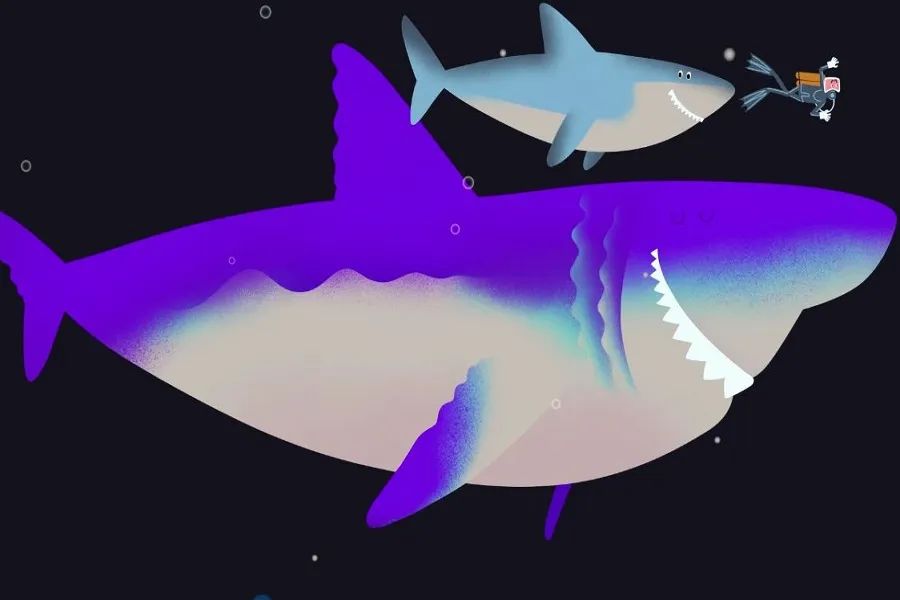TED英语演讲课
给心灵放个假吧

演讲题目:Why did Megalodon go extinct?
演讲简介:
两千万年前,海洋中栖息着一种庞大的生物,它的胃能达到一万升的容量,足以装下一头虎鲸。它是巨齿鲨,史上最大的鲨鱼。那么巨齿鲨称霸时期是怎样的呢?是什么导致这个凶猛的捕食者灭绝?
中英文字幕
In 1667, a Danish scientist finally concluded that certain mysterious stones prized for their supposed medicinal powers,
1667年一位丹麦科学家得出结论,某些被认为具有药用功效的神秘石头,
hadn’t fallen from the sky during lunar eclipses and weren’t serpent tongues.
并非在月食期间从天而降,也不是巨蛇的舌头。
In fact, they were fossilized teeth— many belonging to a prehistoric species that would come to be called megalodon, the biggest shark to ever live.
事实上,它们是牙齿化石——其中许多属于一类史前物种,后来被命名为巨齿鲨,有史以来最大的鲨鱼。
So what was it like when megalodon ruled the seas?
那么当巨齿鲨称霸海洋时是怎么样的?
And what brought this formidable predator to extinction?
是什么致使这个凶猛的捕食者灭绝?
Because their skeletons were cartilaginous, what remains of megalodons are mostly scattered clues,
因为它们的骨架由软骨所组成,巨齿鲨的残骸主要是零星的线索,
like some isolated vertebrae and lots of their enamel-protected teeth.
像落单的脊椎骨和大量釉质保护的牙齿。
Like many sharks, megalodons could shed and replace thousands of teeth over the course of their lives.
像许多鲨鱼一样,巨齿鲨在一生中会脱落并更换数千颗牙齿。
Interestingly, some fossil sites harbor especially high numbers of small megalodon teeth.
有趣的是,一些化石地点发现了极高数量的小型巨齿鲨牙齿。
Experts believe these were nurseries that supported countless generations of budding megalodons.
专家认为那是养育无数代新生巨齿鲨的“育儿园”。
They grew up in sheltered and food-packed shallow waters before becoming unrivaled adult marine hunters.
它们在相对安全、食物充沛的浅水地带长大,直到成为不可比拟的成年海洋猎手。
Looking at the similarities with great white shark teeth,
根据与大白鲨牙齿的相似性,
scientists estimate that megalodons might have stretched up to 20 meters— three times longer than great whites.
科学家估计巨齿鲨可能体长20米多——这是大白鲨的三倍。
And during their reign, which began around 20 million years ago, megalodons lived just about everywhere,
在大约始于两千万年前的巨齿鲨统治期,巨齿鲨几乎无处不在,
with individuals also potentially undertaking transoceanic migrations.
个别巨齿鲨还可能进行跨洋迁徙。
The world was warmer and the ocean was brimming with life.
世界更为温暖,海洋中充满着生命。
Otters and dugongs thrived in newly formed kelp forests, and baleen whales were at their most diverse.
海獭和儒艮在新形成的海带林中蓬勃生长,须鲸也是最为多样的。
Megalodons had no shortage of high-energy, edible options.
巨齿鲨并不缺乏高热量的食用选项,
And it seems they were ambitious eaters.
而且它们似乎是野心熊熊的捕猎者。
Generally, as carnivores consume protein-rich meat, certain nitrogen isotopes accumulate in their tissues— including the enamel of their teeth.
一般地,当肉食者摄入高蛋白的肉类,一些氮同位素会聚集在其组织中,包括牙齿的釉质。
Analyzing megalodon teeth, scientists confirmed they were apex predators that not only ate large prey species— but also other predators,
通过分析巨齿鲨牙齿,科学家们证实它们是顶尖猎手,不仅捕食大型猎物,还捕食他掠食者,
perhaps even each other.
甚至会自相残杀。
In addition to megalodon’s teeth,
在巨齿鲨的牙齿之外,
researchers have access to one exceptionally well-preserved spinal column that comprises 141 vertebrae of a 46-year-old megalodon.
研究人员获得了一具保存绝佳完好的脊椎,由一头46岁巨齿鲨的141个脊椎骨所组成。
A 3D model of the megalodon’s body suggests that its stomach could reach volumes of almost 10,000 liters— big enough to fit an entire orca.
巨齿鲨身体的三维模型显示,它的胃可达到近乎一万升的容量——足以装下一整头虎鲸。
Reconstructing their jaws, researchers think megalodons could eat a now-extinct 7-meter sperm whale in as few as four bites.
重建它们的颚骨之后,研究者认为,只需四口巨齿鲨就能吞下一头现已灭绝的7米长抹香鲸。
And the fossilized bones of ancient cetaceans do indeed show evidence of megalodon bite marks— including some that healed over,
古鲸类骨骼化石确实显示出巨齿鲨咬痕的证据,包括一些已经愈合的咬痕,
confirming that megalodons pursued live prey.
证实了巨齿鲨追踪活的猎物。
But if megalodons were so powerful, why did they go extinct?
但如果巨齿鲨这么强大,它们为什么走向灭绝?
It seems there were a few contributing factors.
似乎有几个因素。
By the time they disappeared around 3.5 million years ago, the global climate had cooled, causing more glaciers to form and the sea level to drop.
在差不多350万年前它们消失时,全球气候变冷,导致更多冰川形成、海平面下降。
This dried up many coastal habitats, meaning some of the world’s most resource-rich marine sites were lost.
这使得许多沿海栖息地干涸,意味着世界上资源富集的海洋区域消失。
About a third of all marine megafauna eventually went extinct, so fewer prey species were available.
约三分之一的海洋巨型动物最终灭绝,因此可供捕食的猎物种类减少。
And megalodons already faced high energetic demands because of their size and the mechanism they likely used to regulate their body temperature,
而巨齿鲨因为它们的体型和可能用来调节体温的机制使其能游经寒冷水域并快速攻击猎物,所以能量需求较高,
which allowed them to navigate cold waters and attack prey with bursts of speed.
这使它们能够在冰冷的水域中航行,并以突如其来的速度攻击猎物。
Environmental changes may have made megalodons vulnerable and increasingly put them in competition with other predators,
环境变化也许使得巨齿鲨更加脆弱,并使它们更多地与其他捕食者竞争,
including the great white shark, a relative newcomer.
包括大白鲨,相对较新的捕食者。
Because megalodons were highly mobile predators, their extinction had global consequences.
因为巨齿鲨是高度灵活的捕猎者,它们的灭绝有着全球性的影响。
The end of their long-distance travels probably disrupted nutrient transport between different ecosystems.
它们长距离迁徙的结束,很可能破坏了不同生态系统之间的营养物质运输。
And many animals were suddenly released from the immense predatory pressure of their bite.
许多动物突然不再承受巨大的捕食压力。
Interestingly, some marine mammals dramatically increased in size afterwards,
有趣的是,一些海洋哺乳动物在后来体型显著增大,
which was perhaps partially afforded because they were no longer dealing with such a mega-existential threat.
也许是因为它们不再面对如此庞大的威胁。
Knowing that the decline of apex predators can destabilize entire ecosystems,
由于知道顶级掠食者的减少会颠覆整个生态系统,
conservationists are working to prevent today’s sharks from facing a similar fate— this time, because of humans.
保护主义者在尝试避免今天的鲨鱼走向类似的结局——这回是因为人类。
And meanwhile, the megalodon remains a colossal testament to ecological interdependence and millions of years of bones well-bitten and waters well-wandered.
同时,巨齿鲨仍然是生态相互依存的重大见证,是其数百万年前咬碎猎物、漫游海洋的重大见证。
视频、演讲稿均来源于TED官网
———END———
限 时 特 惠: 本站每日持续更新海量各大内部创业教程,永久会员只需98元,全站资源免费下载 点击查看详情
站 长 微 信: yjxmw518




